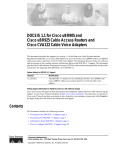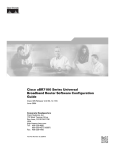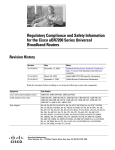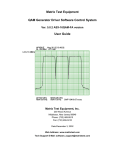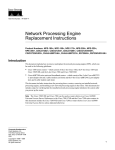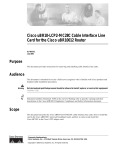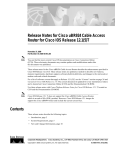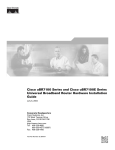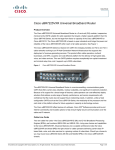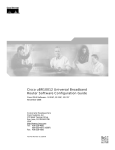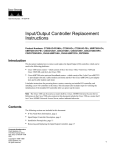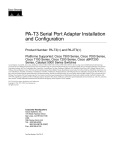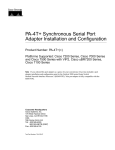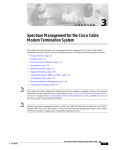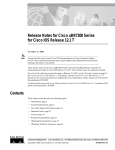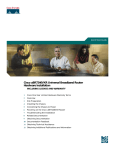Download Cisco MC16E Specifications
Transcript
Cisco − Determining RF or Configuration Issues On the CMT Cisco − Determining RF or Configuration Issues On the CMTS Table of Contents Determining RF or Configuration Issues On the CMTS................................................................................1 Introduction.............................................................................................................................................1 Before You Begin...................................................................................................................................1 Conventions......................................................................................................................................1 Prerequisites.....................................................................................................................................1 Components Used.............................................................................................................................2 RF Plant Troubleshooting Rules.............................................................................................................2 Cable Show Commands for RF Problems..............................................................................................3 DOCSIS Cable Upstream RF Specifications...................................................................................4 DOCSIS Cable Downstream RF Specifications..............................................................................5 Notes for Tables...............................................................................................................................6 Checking the Downstream...............................................................................................................6 Checking the Upstream....................................................................................................................8 Using the Flap List for Diagnosing RF Problems.................................................................................15 Related Information..............................................................................................................................16 i Determining RF or Configuration Issues On the CMTS Introduction Before You Begin Conventions Prerequisites Components Used RF Plant Troubleshooting Rules Cable Show Commands for RF Problems DOCSIS Cable Upstream RF Specifications DOCSIS Cable Downstream RF Specifications Notes for Tables Checking the Downstream Checking the Upstream Using the Flap List for Diagnosing RF Problems Related Information Introduction This document describes the troubleshooting steps to determine whether a cable network problem is in a cable router or an RF plant issue. The majority of RF plant issues are diagnosed by low upstream Signal to Noise Ratio (SNR) level, hence heavy emphasis is placed on examining this value. Initially the document states some simple rules to follow, together with an explanation of how the upstream SNR level is calculated. It then illustrates the major configuration parameters and commands to use to verify the downstream and upstream channels. It finishes with an explanation of the flap list command to further diagnose RF issues. Using a spectrum analyzer for troubleshooting the RF plant is beyond the scope of this document. If the SNR level or other analysis points towards an RF plant issue and you wish to troubleshoot this area further using a spectrum analyzer, then refer to the Connecting and Configuring the Cable Headend in the related information section. All uBR7100, uBR7200, and uBR10000 models, and NPE cards with different Cable Cisco IOS® Software versions follow the same principle in troubleshooting whether this is an RF issue or not. The only difference may be some command syntax changes and performance capabilities, and the fact that the uBR7100 has an integrated upconverter. Before You Begin Conventions For more information on document conventions, see the Cisco Technical Tips Conventions. Prerequisites This document assumes that the reader has access to a Cisco uBR9xx or CVA120 series cable modem to assist in their troubleshooting. Cisco − Determining RF or Configuration Issues On the CMTS Components Used The information in this document is based on Cisco hardware uBR7246 VXR (NPE300) processor (revision C) and Cisco IOS Software (UBR7200−K1P−M), Version 12.1(9)EC and a CVA122 Cisco IOS Software 12.2(2)XA. RF Plant Troubleshooting Rules • The RF plant can be thought of as a MAC layer two equivalent. Usually, if there is a problem with the RF plant, then layer two connectivity will not be established. If the show cable modem command indicates that the online state has progressed past init(rc) status, then this is an indication that layer two connectivity has been established and usually does not indicate an RF problem. However it is possible for the Cable Modem to go past init(rc) and even as far as init(i) but still have RF issues. In this case using a narrower upstream channel may prove the problem is RF−related. See the cable upstream 0 channel−width xxx command. • Before installing a live network always verify the cable router configurations in a controlled environment such as a laboratory where the RF plant characteristics are known. Thus when installing in a live network the characteristics of the router configurations are known and can be eliminated as a problem source. A good RF design is imperative to make this work. Documents that should be read before putting the cable network into production use are Connecting and Configuring the Cable Headend and RF Specifications. • The downstream direction is a broadcast domain. a problem that is affecting a large number of cable modems (or all cable modems), it is likely to be in the downstream plant. • The upstream direction is based on individual circuits per cable modem. Most cable network problems are in the upstream direction. A problem affecting individual or small groups of cable modems may be in the upstream direction. However, loose connections, downstream ingress, and drop problems could affect the downstream signal to an individual cable modem. Likewise, a problem with an individual downstream laser, optical link, node, or coax plant beyond the node could affect just a small number of modems. • Many upstream cable modem problems are caused by low signal to noise ratio (SNR). However, note that the Broadcom chip SNR estimate could indicate apparent normal operation, yet impulse noise (or a similar impairment not indicated by the SNR) may be the real culprit. The show controller cable x/x and show cable modem detail commands interrogate the Broadcom 3137 chip on the uBR72xx line cards that computes the upstream SNR value . Note that carrier−to−noise ratio, or CNR, is a more appropriate term, since SNR is really a post−detection baseband measurement. Below is an explanation of how the upstream is calculated. • The settings on an external upconverter used when having uBR7200 and uBR10000 need to be properly set. Remember that GI Upconverters are configured 1.75 MHz less than the Center Frequency according to the NTSC table. For an explanation of why this is so, please read Cable Radio Frequency (RF) FAQs. • Different MC cards have different output power on the downstream port. For this reason, for some cards it is necessary to add padding (external attenuation). Make sure that you follow the specifications on how much padding to add with regards to the specific linecard used. MC11 and MC16B cards give an output power of 32 dBmV and they do not need padding. However, all the other MCxx cards give an output power of 42 dBmV and therefore need 10dB padding. For more information about the cards specifications read Features, Differences, and IOS Support for Cable Modem Cards for Cisco uBR7200 Series. The SNR estimating process uses only packets that are free from uncorrectable forward error corrections (FEC) errors and is averaged over 10,000 received symbols. If the packet is damaged it is not counted, and the upstream SNR estimate can read artificially high. The upstream SNR estimate does not take into account the real world of burst noise, impulse or intermittent noise that is common in CATV upstream networks. Cisco − Determining RF or Configuration Issues On the CMTS Comparing the Broadcom's upstream SNR estimate to what one would measure with a spectrum analyzer will often yield quite different results. The Broadcom chips upstream SNR estimating process is most reliable in the 25 to 32 dB range. If the upstream SNR estimate reaches 35 dB or greater consider the result to be unreliable and gain a true upstream CNR measurement using a spectrum analyzer. The optimal period to collect the 10,000 symbols is 10−20 msec of 100% utilization upstream for a 3.2 or 1.6 MHz channel width. It would not be usual to have this quantity of traffic being passed and at the same time to be experiencing a low upstream SNR. The lower the upstream SNR the greater the degradation of traffic passed. This degradation causes the Broadcom chip to take too long to collect the 10,000 symbols and for the resulting upstream SNR estimate to be inaccurate. If the upstream SNR estimate falls below 25 dB consider it to be unreliable. At this low upstream SNR level the system is experiencing lots of errors and too little traffic. Expect a lot of flap list entries and SID connectivity numbers to be low. The command show cable hop should indicate lots of FEC correctable and uncorrectable errors. After mentioning the above limitations however, if the upstream SNR level is between 25 and 32 dB as shown by show controller cable x/x , use this command to determine whether there is an apparent RF issue. The upstream CNR estimate is generally 3−4dB lower than the upstream SNR estimate. In a typical cable plant you should expect to see an upstream SNR of 32−33dB and an upstream CNR of 28−29dB. Cable Show Commands for RF Problems The following show commands are used on the CMTS to help diagnose RF issues: • show controllers cable x/x downstream • show controllers cable x/x upstream • show cable modem detail • show interface cable x/x upstream y • show cable hop • ping docsis • show cable flap−list The following show commands are used on the CM to help diagnose RF issues: • show controllers cable−modem 0 | include snr For reference also refer to the Understanding Show Command Responses document. The show controllers cable x/x downstream and show controllers cable x/x upstream commands can be used to show the layer two status of the cable card on the CMTS when diagnosing suspected RF problems. Use these commands to check the frequency settings being used and the upstream SNR value. The show controllers cable x/x upstream command should be entered several times to see if the SNR value fluctuates rapidly. Even with good upstream SNR values a very rapid fluctuation also means RF problems. Use the show interface cable x/x upstream y command to check for noise within the RF plant. If the uncorrectable errors, noise and microreflection counters are high and increasing quickly, then this typically indicates there is noise present within the RF plant. You can also use the ping docsis command to verify the layer two connectivity to the cable modem. Use these commands to check: • The configuration parameters Cisco − Determining RF or Configuration Issues On the CMTS • The downstream and upstream frequencies used • The noise measurements in dB. Make certain that they are correct and within the allowed limits. A table of the noise limits is included below: DOCSIS Cable Upstream RF Specifications Note: *n indicates additional information below. Specifications UPSTREAM DOCSIS Specifications *1 Minimum Settings *2 System/Channel Frequency range Transit delay from the most distant CM to the nearest CM or CMTS. Carrier to noise ratio Carrier to ingress power ratio Carrier to interference ratio Carrier hum modulation Burst noise Amplitude ripple Group delay ripple Micro reflections (single echo) 5 to 42 MHz (North America) 5 to 65 MHz (Europe) < 0.800 µsec < 0.800 µsec 25 dB 25 dB > 25 dB > 25 dB > 25 dB (QPSK) *4 > 21 dB (QPSK) *4 > 25 dB (16 QAM) *4 > 24 dB (16 QAM) *4 < −23 dBc *6 (7%) < −23 dBc (7%) Not longer than 10 µsec at a Not longer than 10 µsec 1 kHz average rate for most at a 1 kHz average rate cases. for most cases. 0.5 dB/MHz 0.5 dB/MHz 200 ns/MHz −10 dBc @ < 0.5 µsec 200 Ns/MHz −20 dBc @ < 1.0 µsec 30 dBc @ 1.0 µsec Seasonal/diurnal signal level variation Digital Signal Levels From cable modem (upstream) 5 to 42 MHz (North America) 5 to 65 MHz (Europe) −10 dBc @ < 0.5 µsec −20 dBc @ < 1.0 µsec 30 dBc @ 1.0 µsec Not greater that 8 dB min to Not greater than 8 dB max. min to max. +8 to +58 dBmV (QPSK) +8 to +58 dBmV (QPSK) +8 to +55 dBmV (16 QAM) Cisco − Determining RF or Configuration Issues On the CMTS +8 to +55 dBmV (16 QAM) Input amplitude to modem card (upstream) Signal as relative to adjacent video signal −16 to +26 dBmV, depending on symbol rate. −16 to +26 dBmV, depending on symbol rate. −6 to −10 dBc −6 to −10 dBc DOCSIS Cable Downstream RF Specifications Specification DOWNSTREAM System/Channel RF channel spacing (bandwidth) Transit delay *3 Carrier to noise ratio Carrier−to−interference ratio for total power (discrete and broadband ingress signals). Composite triple beat distortion Carrier to second order Cross−modulation level Amplitude ripple Group delay DOCSIS Specifications *1 Minimum Settings *2 6 MHz 6 MHz 0.800 µsec 0.800 µsec 35 dB 35 dB > 35 dB > 35 dB < −50 dBc *6 < −50 dBc < −50 dBc < −50 dBc < −40 dBc < −40 dBc 0.5 dB in 6 MHz 0.5 dB in 6 MHz 75 ns in 6 MHz 75 Ns in 6 MHz −10 dBc @ < 0.5 µsec −10 dBc @ < 0.5 µsec Micro reflections bound for dominant echo −15 dBc @ < 1.0 µsec −20 dBc @ < 1.5 µsec −30 dBc @ >1.5 µsec −15 dBc @ < 1.0 µsec −20 dBc @ < 1.5 µsec −30 dBc @ >1.5 µsec Carrier hum modulation Burst noise < −26 dBc (5%) Not longer than 25 µsec at a 10 kHz average rate. < −26 dBc (5%) Not longer than 25 µsec at a 10 kHz average rate. Cisco − Determining RF or Configuration Issues On the CMTS Seasonal/diurnal signal level variation Signal level slope (50 to 750 MHz) Maximum analog video carrier level at the CM input, inclusive of above signal level variation. Minimum analog video carrier level at the CM input, inclusive of above signal level variation. 8 dB 8 dB 16 dB 16 dB +17 dBmV +17 dBmV −5 dBmV −5 dBmV −15 to +15 dBmV −15 to +15 dBmV −6 to −10 dBc −6 to −10 dBc Digital Signal Levels Input to cable modem (Level range, one channel) Signal as relative to adjacent video signal Notes for Tables *1 −DOCSIS specifications are baseline settings for a DOCSIS−compliant, two−way data−over−cable system. *2 − Minimum settings are slightly different than the DOCSIS settings to account for cable system variations over time and temperature. Using these settings should increase the reliability of DOCSIS−compliant, two−way data−over−cable systems. *3 − QPSK = Quadrature Phase−Shift Keying: a method of modulating digital signals onto a radio−frequency carrier signal using four phase states to code two digital bits. *4 − These settings are measured relative to the digital carrier. Add 6 or 10 dB, as determined by your company's policy and derived from the initial cable network setup, relative to the analog video signal. *5 − QAM = Quadrature Amplitude Modulation: a method of modulating digital signals onto a radio−frequency carrier signal involving both amplitude and phase coding. *6 − dBc = decibels relative to carrier. Note: For a full set of the specifications for the European Standard, please read RF Specifications. Checking the Downstream When checking the downstream interface begin by ensuring that the configuration is correct. In most cases when configuring the downstream cable interface on the CMTS the default values are sufficient. You do not need to specify individual parameters unless you want to deviate from system defaults. Use the output below to match the downstream configuration parameters with the matching values seen in the show commands on the CMTS and the cable modem. Cisco − Determining RF or Configuration Issues On the CMTS interface Cable6/1 ip address 192.168.161.1 255.255.255.0 secondary ip address 10.1.61.1 255.255.255.0 no keepalive cable insertion−interval 100 cable downstream annex B cable downstream modulation 64qam cable downstream interleave−depth 32 cable downstream frequency 405000000 cable upstream 0 frequency 20000000 cable upstream 0 power−level 0 cable upstream 0 channel−width 3200000 no cable upstream 0 shutdown cable upstream 1 shutdown cable upstream 2 shutdown cable upstream 3 shutdown VXR#show controller cable 6/1 downstream Cable6/1 Downstream is up Frequency 405.0000 MHz, Channel Width 6 MHz, 64−QAM, Symbol Rate 5.056941 Msps FEC ITU−T J.83 Annex B, R/S Interleave I=32, J=4 Downstream channel ID: 3 VXR# Make sure that the physical CMTS cable connections are not loose or disconnected, and that the cable modem card is firmly seated in its chassis slot with the installation screws tight. Also check that you have entered the correct slot and port numbers for the downstream interface that you are checking. Remember that entering the downstream center frequency on the CMTS is cosmetic only for uBR7200 and uBR10000. The uBR7100 has an integrated Upconverter. To learn how to set it up read Setting the Integrated Upconverter. Entering a shut/no shut command on the downstream interface that you are checking may resolve problems where the cable modems find a downstream signal but not an upstream signal. Important: Using a shut/no shut on the downstream interface in a production environment with several hundred cable modems may cause them to take a long time before coming back online. In non−production environments such as new cable installations it is safe to do this. The downstream SNR value needs to be checked at the cable modem where it is received and not at the CMTS where it is input into the upconverter that is responsible for the signal sent to the cable modem. This measurement at the cable modem can pose the following problems: • Most cable installations do not have Cisco cable modems. Even if they do, the console port on the Cable Modem is by default locked. • You have to Telnet to the cable modem to measure the received SNR value. If you do not have IP connectivity to Telnet you will have to manually go to the customer site where the Cisco Cable Modem is installed in order to connect using the console port. Ensure that the cable modem has a configuration that allows you access to the console port. At the cable modem, use the show controllers cable−modem 0 | include snr command below to check the downstream SNR value received at the cable modem. Verify that the received SNR level is within the permitted limits of >30 dB for 64 QAM and >35 for 256 QAM. Router#show controller cable−modem 0 | include snr snr_estimate 336(TenthdB), ber_estimate 0, lock_threshold 23000 Cisco − Determining RF or Configuration Issues On the CMTS Router# Note: This is showing a downstream receive SNR of 33.6 dB at the cable modem. Acceptance levels are >30 dB for 64 QAM and > 35 dB for 256 QAM. Annex B is the DOCSIS MPEG framing format standard for North America. Annex A is the European standard supported only when using the Cisco MC16E cable modem card and Cisco CMTS images that support EuroDOCSIS Annex A operation. Annex A or B framing format is automatically set when configuring Cisco cable modem cards. The cable modem card's downstream ports and the connected CPEs on the network must be set to the same MPEG framing format and support either DOCSIS or EuroDOCSIS operations as appropriate. For more information about the MC16E card, read Cisco uBR−MC16E 8−MHz Modem Card. Setting a downstream modulation format of 256−QAM requires approximately a 6 dB higher carrier−to−noise ratio (CNR) than 64−QAM at the subscriber's cable modem. If your network is marginal or unreliable at 256−QAM, use the 64−QAM format instead. If a Cable modem is offline one of the first thing to investigate is the RF plant. For more information read the offline and ranging troubleshooting sections. Checking the Upstream On the upstream side many RF problems are indicated by a low SNR level. Note that upstream impulse noise is the major source of degraded bit error rate performance. The Broadcom SNR estimate generally will not show the presence of impulse noise. Later in this section you will be shown how to check the upstream SNR levels. Begin by checking the upstream interface, ensuring that the configuration is correct. In most cases when configuring the upstream cable interface on the CMTS the default values are sufficient. You do not need to specify individual parameters unless you want to deviate from system defaults. Use the diagram below to match the upstream configuration parameters with the matching values seen in the show commands at the CMTS: interface Cable6/1 ip address 192.168.161.1 255.255.255.0 secondary ip address 10.1.61.1 255.255.255.0 no keepalive cable insertion−interval 100 cable downstream annex B cable downstream modulation 64qam cable downstream interleave−depth 32 cable downstream frequency 405000000 cable upstream 0 frequency 20000000 cable upstream 0 power−level 0 cable upstream 0 channel−width 3200000 no cable upstream 0 shutdown cable upstream 1 shutdown cable upstream 2 shutdown cable upstream 3 shutdown VXR#show controller cable 6/1 upstream 0 Cable6/1 Upstream 0 is up Frequency 19.984 MHz, Channel Width 3.200 MHz, QPSK Symbol Rate 2.560 Msps Spectrum Group is overridden SNR 35.1180 dB Nominal Input Power Level 0 dBmV, Tx Timing Offset 2738 Cisco − Determining RF or Configuration Issues On the CMTS Ranging Backoff automatic (Start 0, End 3) Ranging Insertion Interval 100 ms TX Backoff Start 0, TX Backoff End 4 Modulation Profile Group 1 Concatenation is enabled part_id=0x3137, rev_id=0x03, rev2_id=0xFF nb_agc_thr=0x0000, NB_agc_nom=0x0000 Range Load Reg Size=0x58 Request Load Reg Size=0x0E Minislot Size in number of Timebase Ticks is = 8 Minislot Size in Symbols = 128 Bandwidth Requests = 0x335 Piggyback Requests = 0xA Invalid BW Requests= 0x0 Minislots Requested= 0xA52 Minislots Granted = 0xA52 Minislot Size in Bytes = 32 Map Advance (Dynamic) : 2447 usecs UCD Count = 46476 DES Ctrl Reg#0 = C000C043, Reg#1 = 0 VXR# Make sure that the physical CMTS cable connections are not loose or disconnected and that the cable modem card is firmly seated in its chassis slot with the installation screws tight. Also that you have entered the correct slot and port numbers for the upstream interface you are checking. Remember that the upstream channel on the Cisco cable modem is by default shut down and you will need to issue the no shut command to activate it. Note: The upstream frequency displayed in the show controllers cable command output might not match the frequency that you entered when you set the upstream frequency. The Cisco CMTS might select an upstream frequency close to the frequency you entered that offers better performance. The minimum upstream frequency step size on the MC16C is 32 kHz. The Cisco CMTS selects the closest frequency available. See the explanation of the cable upstream 0 frequency command for this. Note: Some cable systems cannot reliably transport frequencies near the allowed band edges. The wider the upstream channel (in MHz), the more difficulty you might have. Enter a center frequency between 20 and 38 MHz if you experience problems. The Cisco CMTS will then command the cable modems to use a downstream frequency within this range. Setting the right upstream frequency is the most important task in designing the RF network. The upstream operates on the range 5 to 42 MHz. Below 20MHz it is common to find a lot of interference. Contrary to a lab environment, setting up the upstream in a live network represents the biggest RF challenge. Note: Higher symbol rates are more susceptible to RF noise and interference. If you use a symbol rate or modulation format beyond the capabilities of your HFC network you might experience packet loss or poor cable modem connectivity. This can be seen in the figure below where a higher CNR is needed to maintain the same bit error rate (BER) with more complex modulation formats. Cisco − Determining RF or Configuration Issues On the CMTS Waterfall curves. More complex modulation formats require a higher CNR (or C/N ratio) in order to maintain the same BER. The upstream input power level at the CMTS is normally expected to be 0 dBmV. This power level can be increased to overcome noise in the RF plant. If the upstream input power level is increased then cable modems on your HFC network will increase their upstream transmit power level. This increases the carrier−to−noise ratio (CNR) overcoming the noise on the RF plant. See the explanation of the cable upstream x power−level y command for this. You should not adjust your input power level by more than 5 dB in a 30−second interval. If you increase the power level by more than 5 dB within 30 seconds cable modem service on your network will be disrupted. If you decrease the power level by more than 5 dB within 30 seconds cable modems on your network will be forced offline. Software adjustments of 1 to 3 dB can be used to adjust for minor variations in measurement, or setup and port−to−port calibration differences. These adjustments can significantly improve cable modem performance, especially in marginal situations. Larger adjustments should be made in conjunction with spectrum analyzer support at the headend or distribution hub. As mentioned earlier, many RF problems are indicated by a low upstream SNR level. If your upstream SNR level is low try to use a narrower channel width (cable upstream 0 channel−width xxx) for the upstream, for example, instead of 3.2 Mhz use 200 khz. If the upstream SNR level increases then you have a noise problem. Use the show controller cable x/x upstream y command to check the upstream SNR level for a particular cable interface: VXR#show controller cable 6/1 upstream 0 Cable6/1 Upstream 0 is up Frequency 19.984 MHz, Channel Width 3.200 MHz, QPSK Symbol Rate 2.560 Msps Spectrum Group is overridden SNR 35.1180 dB !−− Note: Check the Upstream SNR level for an interface here Nominal Input Power Level 0 dBmV, TX Timing Offset 2738 Ranging Backoff automatic (Start 0, End 3) Ranging Insertion Interval 100 ms TX Backoff Start 0, TX Backoff End 4 Modulation Profile Group 1 Concatenation is enabled part_id=0x3137, rev_id=0x03, rev2_id=0xFF NB_agc_thr=0x0000, NB_agc_nom=0x0000 Cisco − Determining RF or Configuration Issues On the CMTS Range Load Reg Size=0x58 Request Load Reg Size=0x0E Minislot Size in number of Timebase Ticks is = 8 Minislot Size in Symbols = 128 Bandwidth Requests = 0x335 Piggyback Requests = 0xA Invalid BW Requests= 0x0 Minislots Requested= 0xA52 Minislots Granted = 0xA52 Minislot Size in Bytes = 32 Map Advance (Dynamic) : 2447 usecs UCD Count = 46476 DES Ctrl Reg#0 = C000C043, Reg#1 = 0 VXR# You can use the show cable modem detail command to view the SNR estimate for individual cable modems. (Please see the table below for a further explaination of SID, MAC address, Max CPE, etc.) VXR#show cable modem detail Interface SID MAC address Cable6/1/U0 1 0001.64ff.e47d Cable6/1/U0 2 0001.9659.47bf Cable6/1/U0 3 0004.27ca.0e9b Cable6/1/U0 4 0020.4086.2704 Cable6/1/U0 5 0002.fdfa.0a63 SID MAC address Max CPE Concatenation Max CPE 1 1 1 1 1 Concatenation yes yes yes yes yes Service ID Mac address of the cable interface of the Cable Modems The maximum number of hosts that are simultaneously active on the cable modem Concatenation combines multiple upstream packets into one packet to reduce packet overhead and overall latency as well as increase transmission efficiency. Using concatenation, a DOCSIS compliant Cable Modem makes only one bandwidth request for multiple packets, as opposed to making a different bandwidth request for each individual packet. Concatenation will only work if a single cable modem were to have multiple voice calls each running at the same data rate without Voice Activity Detection (VAD) packet suppression. Note: Concatenation may be a problem if VOIP is not configured correctly. Rx SNR Received Upstream SNR level at the CMTS. If the CMTS is not configured for SNMP reads from the Cable Modems then the CMTS will return a zero value. The Signal to Noise Ratio (SNR) is the difference in amplitude between a baseband signal and the noise in a portion of the spectrum. Cisco − Determining RF or Configuration Issues On the CMTS Rx SNR 33.61 31.21 31.14 32.88 33.61 In practice, a margin of 6dB or more may be required for reliable operation. Use the show interface cable x/x upstream y command as shown below to check for noise within the RF plant. If the uncorrectable errors, noise, and microreflection counters are high and increasing quickly, then this typically indicates there is noise present within the RF plant. (Please see the table below for a further information on this output.) VXR# show interfaces cable 6/1 upstream 0 Cable6/1: Upstream 0 is up Received 22 broadcasts, 0 multicasts, 247822 unicasts 0 discards, 1 errors, 0 unknown protocol 247844 packets input, 1 uncorrectable 0 noise, 0 microreflections Total Modems On This Upstream Channel : 1 (1 active) Default MAC scheduler Queue[Rng Polls] 0/64, fifo queueing, 0 drops Queue[Cont Mslots] 0/52, FIFO queueing, 0 drops Queue[CIR Grants] 0/64, fair queueing, 0 drops Queue[BE Grants] 0/64, fair queueing, 0 drops Queue[Grant Shpr] 0/64, calendar queueing, 0 drops Reserved slot table currently has 0 CBR entries Req IEs 360815362, Req/Data IEs 0 Init Mtn IEs 3060187, Stn Mtn IEs 244636 Long Grant IEs 7, Short Grant IEs 1609 Avg upstream channel utilization : 0% Avg percent contention slots : 95% Avg percent initial ranging slots : 2% Avg percent minislots lost on late MAPs : 0% Total channel bw reserved 0 bps CIR admission control not enforced Admission requests rejected 0 Current minislot count : 40084 Flag: 0 Scheduled minislot count : 54974 Flag: 0 VXR# Received broadcasts Broadcast packets received through this upstream interface multicasts Multicast packets received through this upstream interface Unicasts Unicast packets received through this interface Discards Errors Unknown Packets discarded by this interface Sum of all errors that prevented upstream transmission of packets Packets received that were generated using a protocol unknown to the Cisco uBR7246 Noise Upstream packets corrupted by line noise Packets input Packets received through upstream interface free from errors Corrected Error packets received through upstream interface that were corrected Cisco − Determining RF or Configuration Issues On the CMTS Uncorrectable Error packets received through upstream interface that could not be corrected Noise and Upstream packets corrupted by line noise Microreflections Upstream packets corrupted by microreflections Total Modems On This Upstream Channel Number of cable modems currently sharing this upstream channel. This field also shows how many of these modems are active. Rng Polls The MAC scheduler queue showing number of ranging polls. Cont Mslots The MAC scheduler queue showing number of forced contention request slots in MAPS CIR Grants The MAC scheduler queue showing number of CIR grants pending BE Grants The MAC scheduler queue showing number of best effort grants pending Grant Shpr Reserved slot table Req IEs Req/Data lEs Init Mtn IEs Stn Mtn IES Long Grant lEs ShortGrmg lEs Avg upstream channel utilization Avg percent contention slots Avg percent initial ranging slots The MAC scheduler queue showing number of grants buffered for traffic shaping At time command issued MAO scheduler had admitted 2 CBR slots in the reserved slot table. Running counter of request lEs sent in MAPS Counter of request/data lEs sent in MAPS Counter of Initial Maintenance lEs Number of station maintenance (ranging poll) lEs Number of long grant lEs Number of short grantlEs Average percent of the upstream channel bandwidth being used Average percent of slots available for modems to request bandwidth via contention mechanisms. Also indicates the amount of unused capacity in the network. Average percent of slots in initial ranging state Cisco − Determining RF or Configuration Issues On the CMTS Avg percent minislots lost on late Maps Total channel bw reserved Average percent of slots lost because a MAP interrupt was too late Total amount of bandwidth reserved by all modems sharing this upstream channel that require bandwidth reservation. The Class of Service for these modems specifies some non−zero value for the guaranteed upstream rate. When one of these modems is admitted on the upstream, this field value is incremented by this guaranteed−upstream rate value. Note: Check the noise and microreflection counters. They should be very low values and, in a normal cable plant, increment slowly. If they are at a high value and increment quickly it typically indicates a problem with the RF plant. Note: Check for uncorrectable errors. These typically indicate a problem with noise within the RF plant. Check the received upstream SNR level. Use the show cable hop command to check the correctable and uncorrectable FEC error counts for a specific interface or upstream port. Consider that uncorrectable FEC errors result in dropped packets. Correctable FEC errors are right before uncorrectable FEC errors, and should be considered a warning sign of uncorrectable errors yet to come. The information from show cable hop describes the frequency hop status of an upstream port. (Please see the table below for a further information on this output.) VXR#show cable hop cable 6/1 upstream 0 Upstream Port Poll Missed Min Missed Hop Hop Port Status Rate Poll Poll Poll Thres Period (ms) Count Sample Pcnt Pcnt (sec) Cable6/1/U0 20.000 MHz 1000 * * * set to fixed frequency * * * VXR# Upstream Port Port Status Poll Rate Missed Poll Count Min Poll Sample Missed PollPcnt Hop Thres Pcnt Hop Period The upstream port for this information line Lists the status of the port. Valid states are down if frequency is unassigned or administrative down if the port is shut down. If the port is up, this column shows the center frequency of the channel. The rate that station maintenance polls are generated (in milliseconds). The number of missing polls The number of polls in the sample. The ratio of missing polls to the number of polls, expressed as a percentage The level that the missed poll percentage must exceed to trigger a frequency hop, expressed as a percentage. Cisco − Determining RF or Configuration Issues On the CMTS Corr FEC Errors 10 Uncorr FEC Errors 1 The maximum rate that frequency hopping will occur (in seconds) Corr FEC Errors The number of correctable forward error corrections (FEC) errors on this upstream port. FECs measure noise. Uncorr FEC Errors The number of uncorrectable FEC errors on this upstream port You can use the show cable hop command to check for correctable and uncorrectable FEC errors on a particular interface. Counters should have a low value. High or rapidly increasing uncorrectable errors typically indicates a problem with noise within the RF plant. If this is the case, check the received upstream SNR level. Finally use the ping docsis command to verify the layer two connectivity to the cable modem: VXR#ping docsis ? A.B.C.D Modem IP address H.H.H Modem MAC address Note: Use this command to ping either the modem IP or MAC address: VXR#ping docsis 10.1.61.3 Queueing 5 MAC−layer station maintenance intervals, timeout is 25 msec: !!!!! Success rate is 100 percent (5/5) VXR# Using the Flap List for Diagnosing RF Problems One of the most powerful tools on the CMTS for diagnosing RF problems on cable networks is the show cable flap−list command. To assist in locating cable plant problems the CMTS maintains a database of flapping cable modems . In this document we highlight the most important things that are used by this feature from a practical point of view. For very detailed information about the flap list feature, please read Flap−List Troubleshooting for the Cisco Cable Modem Termination System, which contains all you want to know about this feature. Below is a sample output from the show cable flap−list command. Note that an asterisk appears in the power adjustment field when an unstable return path for a particular modem has been detected and a power adjustment has been made. An exclamation point appears when so many power adjustments have been made that the modem has reached its maximum power transmit level and cannot increase it any further. Both of these indicate a problem in the RF plant. VXR#sh cable flap−list MAC Address Upstream 0001.64ff.e47d Cable6/1/U0 0001.9659.47bf Cable6/1/U0 0004.27ca.0e9b Cable6/1/U0 0020.4086.2704 Cable6/1/U0 0002.fdfa.0a63 Cable6/1/U0 Ins 0 0 0 0 0 Hit 20000 30687 28659 28637 28648 Miss 1 3 0 4 5 CRC 0 0 0 0 0 * P−Adj *30504 *34350 !2519 2468 2453 Means that a power adjustment has been made ! Indicates that a cable modem increased its power level to the maximum level. For Cisco cable modems that equals 61 dBmV. Cisco − Determining RF or Configuration Issues On the CMTS Flap 30504 34350 2519 2468 2453 Time Oct 25 Oct 25 Oct 23 Oct 23 Oct 23 08:35:32 08:35:34 16:21:18 16:20:47 16:21:20 The flap list is an event detector, and there are three situations that causes an event to be counted. Below is a description of these events that cause a cable modem to be entered into the flap list. 1. REINSERTIONS First, we might see flaps along with insertions if a modem has a registration problem and keeps trying to quickly reregister over and over. The P−Adj column may be low. When the time between two initial maintenance re−registrations by the CM is less than 180 seconds, you'll get "flaps" along with "insertions." Therefore, the flap detector will count it. This default value of 180 seconds can be changed if desired. Reinsertions also help to identify potential problems in the downstream because improperly provisioned cable modems tend to try to reestablish a link repeatedly: VXR(config)#cable flap−list insertion−time ? <60−86400> Insertion time interval in seconds 2. HIT/MISSES Secondly, the flap detector will count a flap when we see a "miss" followed by a "hit". Event detection is counted in the "Flap" column only. These polls are hello packets that are sent every 30 seconds. If we get a "miss" followed by a "miss" the polls will be sent every second for 16 seconds vigorously attempting to get a response. If we get a "hit" before the 16 seconds are up, you'll get a flap but if you don't get a "hit" for 16 polls, the modem will go off−line in order to begin initial maintenance all over again. If the modem finally comes back online, you'll get an "insertion" because the CM inserted itself back into an active state. The flap count is incremented if there are 6 consecutive misses. This default value can be changed if desired. If there are a number of misses then this typically points to a potential problem in the upstream: VXR(config)#cable flap miss−threshold ? <1−12> missing consecutive polling messages 3. POWER ADJUSTMENTS Finally, the flap detector will show a "flap" in the list when we see power adjustment activity. Event detection is counted in the P−Adj columns and the "Flap" column. The station maintenance poll constantly adjusts the cm transmit power, frequency, and timing. Whenever the power adjustment exceeds 2 dB then the "Flap" and the P−Adj" counter is incremented. This suggests upstream plant problems. The threshold default value of 2 dB can be changed if desired. If constant power adjustments are detected, this usually indicates a problem with an amplifier. By looking at the cable modems in front and behind various amplifiers, you can find the source of failure: VXR(config)#cable flap power−adjust ? threshold Power adjust threshold Related Information • Understanding System Operations • Troubleshooting the Hardware Installation • HUKK Online RF Training • Connecting and Configuring the Cable Headend • Flap−List Troubleshooting for the Cisco Cable Modem Termination System • RF Specifications • Cable Radio Frequency (RF) FAQs • Understanding Show Command Responses Cisco − Determining RF or Configuration Issues On the CMTS • Features, Differences, and IOS Support for Cable Modem Cards for Cisco uBR7200 Series • Technical Support − Cisco Systems All contents are Copyright © 1992−2003 Cisco Systems, Inc. All rights reserved. Important Notices and Privacy Statement. Cisco − Determining RF or Configuration Issues On the CMTS



















